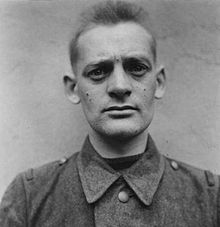Franz Starkfl
Franz Starkfl alias Xaver Starkfel alias Franz Stofel (born October 5, 1915 in Hamburg ; † December 13, 1945 in Hameln ) was a German SS-Hauptscharführer and camp leader in the Kleinbodungen subcamp of the Mittelbau concentration camp .
Life
Starkfl was a member of the Reichswehr from October 1934 to 1935 . In his opinion, the SS , which he joined in April 1936 , offered the opportunity to become a professional soldier . As a result, he was assigned to the guard ( SS-Totenkopfstandarte ) of the Dachau concentration camp . From March 1939 to January 1944, Starkfl was deployed directly in the camp area of the Dachau concentration camp, where, among other things, he led small work details. In mid-January 1944 he was transferred to the Dora-Mittelbau concentration camp and from August 1944 worked as a commando leader in setting up a satellite camp in Kleinbodungen .
From October 3, 1944 to the beginning of April 1945, he was camp leader of the Kleinbodungen satellite camp . This satellite camp contained around 620 prisoners who had to do forced labor for Mittelwerk GmbH in a rocket repair plant for the A4 surface-to-surface missile (better known as V2) .
After Franz Hössler ordered Starkfl to evacuate the Kleinbodungen sub-camp on April 4, 1945 , 610 prisoners under the direction of Stark and his deputy Wilhelm Dörr and 45 SS men left the sub-camp on April 5, 1945 . Originally the order was to transport the prisoners from Herzberg by train. Due to air strikes, however, Strfl decided to transfer the prisoners on a death march to the nearest concentration camp, Bergen-Belsen . On April 10, 1945, after some prisoners had already managed to escape, the evacuation transport ended up in a combat zone near Groß Hehlen north of Celle . During the fighting, four to five prisoners were shot by field units because they attempted to flee and the march was too slow. On April 11, 1945, the evacuation transport arrived at the Bergen-Belsen concentration camp with 590 prisoners.
On April 15, 1945, the Bergen-Belsen concentration camp was liberated by British troops who found over 10,000 dead and around 60,000 survivors there. The SS camp personnel were obliged to remove all corpses and bury them in mass graves .
Then Starkfl was arrested and interrogated by British military personnel. In the Bergen-Belsen trial (September 17 to November 17, 1945) he was charged with his responsibility for the death march. Starkfl, who pleaded “not guilty”, was found guilty on November 17, 1945 and, like Dörr, sentenced to death by hanging . The British executioner Albert Pierrepoint carried out the sentences on December 13, 1945 in Hameln prison .
literature
- United Nations War Crimes Commission (Ed.): Law reports of trials of war criminals, selected and prepared by the United Nations War Crimes Commission. 3 volumes, William S. Hein Publishing, Buffalo (New York) 1997, ISBN 1-57588-403-8 (reprint of the original edition from 1947–1949)
- Jens-Christian Wagner : Production of death: The Mittelbau-Dora concentration camp , Wallstein Verlag, Göttingen 2001, ISBN 3-89244-439-0 .
- Jens Christian Wagner: Kleinbodungen sub-camp. In: Wolfgang Benz , Barbara Distel (eds.): The place of terror . History of the National Socialist Concentration Camps. Volume 7: Niederhagen / Wewelsburg, Lublin-Majdanek, Arbeitsdorf, Herzogenbusch (Vught), Bergen-Belsen, Mittelbau-Dora. CH Beck, Munich 2008, ISBN 978-3-406-52967-2 .
Web links
- Mazal: First Belsen Trial: Logs - statement Stärfls on October 23, 1945 (Engl.)
- Photos and features of the defendants
Individual evidence
- ↑ Jens-Christian Wagner : Production of death: Das KZ Mittelbau-Dora , Göttingen 2001, p. 673
-
^ Statement by George Kraft in the Bergen-Belsen trial of October 11, 1945.
According to Jens-Christian Wagner, strengfel was SS-Hauptsturmführer, see: Jens Christian Wagner: Kleinbodungen satellite camp. In: Wolfgang Benz , Barbara Distel (eds.): The Place of Terror - History of the National Socialist Concentration Camps , Volume 7, Munich 2008, p. 317. - ↑ a b c Mazal: First Bergen-Belsen Trial: Protocols - Statement by Stark on October 23, 1945
- ^ A b Jens Christian Wagner: Kleinbodungen satellite camp. In: Wolfgang Benz , Barbara Distel (eds.): The Place of Terror - History of the National Socialist Concentration Camps , Volume 7, Munich 2008, p. 316 f.
- ^ Andrè Sellier: Forced Labor in the Rocket Tunnel - History of the Dora Camp , Lüneburg 2000, p. 395
- ↑ Karin Orth: The Concentration Camp SS , Munich 2004, p. 265f.
| personal data | |
|---|---|
| SURNAME | Strong, Franz |
| ALTERNATIVE NAMES | Starch, Xaver; Stofel, Franz |
| BRIEF DESCRIPTION | German SS-Hauptscharführer and camp leader in the Kleinbodungen subcamp of the Mittelbau concentration camp |
| DATE OF BIRTH | October 5, 1915 |
| PLACE OF BIRTH | Hamburg |
| DATE OF DEATH | December 13, 1945 |
| Place of death | Hamelin |
